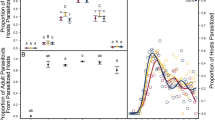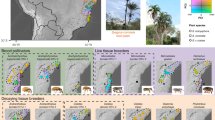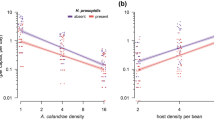Abstract
The importance of variation in the ability of individuals to survive or perform on different types of resource (implicit in evolutionary studies) has been discussed in both host–parasite1 and plant-insect systems2–4. But variation in host-choice behaviour and its interaction with offspring performance on variable resources5 has been studied only in insect populations that each use several plant species6,7. Here I show that in a natural population of the butterfly Euphydryas editha (Nymphalidae), some females are specialized in both oviposition behaviour and offspring performance. These specialists prefer to lay eggs on certain individuals of the host plant Pedicularis semibarbata (Scrophulariaceae) that also improve the survival of their offspring. Other E. editha females in the same population are not so specialized. They show no oviposition preference among individual P. semibarbata, and survival of their offspring is not correlated with the plant suitability categories defined by the specialists. Thus information vital to understanding the true nature of the interactions in a plant–insect system is lost when the process is described using either the average ability of an insect population to exploit a plant population or the average ability of a plant to resist attack by an insect species.
This is a preview of subscription content, access via your institution
Access options
Subscribe to this journal
Receive 51 print issues and online access
$199.00 per year
only $3.90 per issue
Buy this article
- Purchase on Springer Link
- Instant access to full article PDF
Prices may be subject to local taxes which are calculated during checkout
Similar content being viewed by others
References
May, R. M. & Anderson, R. M. in Coevolution (eds Futuyma, D. J. & Slatkin, M.) 186–206 (Sinaur, Sunderland, 1983).
Edmunds, G. F. Jr & Alstad, D. N. Science 199, 941–945 (1978).
Mitter, C. & Futuyma, D. J. in Variable Plants and Herbivores in Natural and Managed Systems (eds Denno, R. F. & McClure, M. S.) 427–459 (Academic, New York, 1983).
Gould, F. in Variable Plants and Herbivores in Natural and Managed Systems (eds Denno, R. F. & McClure, M. S.) 599–653 (Academic, New York, 1983).
Futuyma, D. J. & Peterson, S. A. Rev. Ent. 30, 217–238 (1985).
Via, S. Evolution 40, 778–785 (1986).
Singer, M. C., Ng, D. & Thomas, C. D. Evolution 42, (in the press).
Rausher, M. D., Mackay, D. A. & Singer, M. C. Anim. Behav. 29, 1220–1228 (1981).
Makay, D. A. Ecol. 66, 142–151 (1985).
Singer, M. C. in Insect-Plant Interactions (eds Miller, J. R. & Miller, T. A.) 65–94 (Springer, New York, 1986).
Ng, D. Dissertation, Univ. Texas (1987).
Moore, S. D. Dissertation, Univ. Texas (1987).
Rausher, M. D. & Papaj, D. R. Ecology 64, 1402–1410 (1983).
Myers, J. H. J. Anim. Ecol. 54, 193–204 (1985).
Morrow, P. S. & LaMarche, V. C. Science 201, 1244–1246 (1978).
Marquis, R. J. Science 226, 537–539 (1984).
Futuyma, D. J. in Coevolution (eds Futuyma, D. J. & Slatkin, M.) 207–231 (Sinaur, Sunderland, 1083).
Berenbaum, M. R., Zangerl, A. R. & Nitao, J. K. Evolution 40, 1215–1228 (1986).
Scriber, J. M. in Variable Plants and Herbivores in Natural and Managed Systems (eds Denno, R. F. & McClure, M. S.) 373–412 (Academic, New York, 1983).
Janzen, D. H. in Herbivores: Their Interactions With Secondary Plant Metabolites (eds Rosenthal, G. A. & Janzen, D. H.) 331–350 (Academic, London, 1979).
Author information
Authors and Affiliations
Rights and permissions
About this article
Cite this article
Ng, D. A novel level of interactions in plant–insect systems. Nature 334, 611–613 (1988). https://doi.org/10.1038/334611a0
Received:
Accepted:
Issue Date:
DOI: https://doi.org/10.1038/334611a0
This article is cited by
-
Flight and Oviposition Behavior of the Adult Maritime Ringlet (Coenonympha nipisiquit McDunnough) Females in Response to Microhabitat
Journal of Insect Behavior (2009)
-
Host plant use by the Heath fritillary butterfly, Melitaea athalia: plant habitat, species and chemistry
Arthropod-Plant Interactions (2008)
-
Good mothers, bad mothers, and the nature of resistance to herbivory in Solidago altissima
Oecologia (2008)
-
Covariance of preference and performance on normal and novel hosts in a locally monophagous and locally polyphagous butterfly population
Oecologia (2003)
-
Within- and among-population variation in oviposition preference for urea-supplemented food inDrosophila melanogaster
Journal of Biosciences (1997)
Comments
By submitting a comment you agree to abide by our Terms and Community Guidelines. If you find something abusive or that does not comply with our terms or guidelines please flag it as inappropriate.



